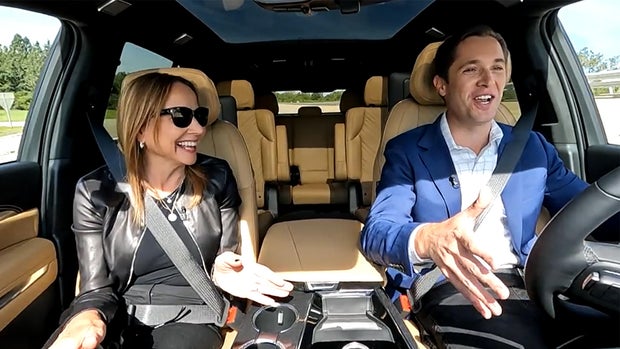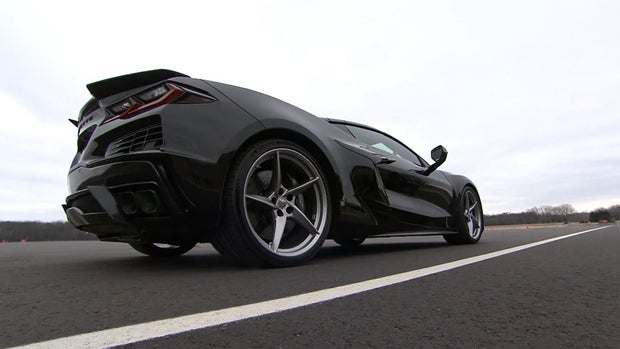During her ten years as CEO of General Motors, Mary Barra has made big investments in software and driverless cars. At a 2021 trade show, Barra said, “At General Motors our vision for the future is a world with zero crashes, zero emissions, and zero congestion. The key to unlock that vision is electrification.”
But it was her promise three years ago to stop selling gas-powered vehicles by 2035 – and GM’s ability to live up to it – that will likely define her legacy.
Asked if she anticipates GM will be all-electric by 2035, Barra replied, “For our light-duty vehicles, yes. We’ll be guided by the consumer, but the plans that we have in place will get us there.” Nonetheless, in the face of slowing EV sales, Barra said, “I don’t think we ever thought it was gonna be linear.”
CBS News
Wall Street darling Tesla still dominates the market with nearly half of the EVs on the road in the United States. But their market share is shrinking. And with nine all-electric cars and trucks currently available, and four more on the way, GM seems determined to catch up.
“Sunday Morning” was the first to drive GM’s highly-anticipated and soon-to-be-released electric Cadillac Escalade IQ. Starting around $130,000, with a range of at least 460 miles per charge, it includes features like the semi-autonomous Super Cruise, which allows hands-free driving on many roads.
CBS News
For a peak at what else is around the corner, GM invited us for a rare look inside its century-old Milford Proving Ground. A 45-minute drive from the company’s headquarters in Detroit, the Proving Ground has long been a hub for automotive innovation. GM conducted the industry’s first rollover test, and the first crash test using those famous dummies, all right here.
Today, the 4,000-acre site is home to more than 140 miles of every kind of test track imaginable, from off-road to brick road, even an honest-to-goodness race track.
Tony Roma, the executive chief engineer for Corvette, took us for a spin in the new ZR1. With 1,064 hp and a top speed over 200 mph, it’s the fastest Corvette ever. On this day we managed to hit 170.
CBS News
Van Cleave asked, “With all of the computer modeling you guys do now, why is any of this necessary?”
“You still need to stress the components to correlate the models,” Roma replied.
Every detail of the ZR1 is being perfected at Milford, from the handling to that signature Corvette sound. “We put a lot of effort into the sound – the startup sound, the sound when it’s accelerating,” Roma said. “We’ll do 50 or 60 different iterations. It’s like tuning an instrument.”
“On some level, does a Corvette always need to be a gas-powered vehicle?” asked Van Cleave. “Can you have that sound and that feel [with a hybrid]?”
Roma replied, “We talk about this a lot. I talk about this with enthusiasts, my friends, other engineers.”
Last year, GM’s introduction of its hybrid Corvette, the E-Ray, was met with some initial skepticism. But that has not dampened speculation that an all-electric Corvette isn’t far behind, fueled in part by President Biden, who said in 2021, “I have a commitment from Mary. When they make the first electric Corvette, I get to drive it!”
CBS News
According to Roma, “We’re not going to apply electrification just for the sake of it. We don’t put technology on just for technology’s sake. It kind of has to earn its way in, has to make the car better in some way that our customers are going to respond to.”
Most Americans have so far been reluctant to make the switch and plug in. Last year, electric vehicles made up only about eight percent of new car sales; and government subsidies aimed at speeding the transition have become a contentious issue on the campaign trail.
Barra was surprised that EVs have become a political issue: “I never thought the propulsion system on a vehicle would be,” she said. “Again, I think one of the strengths of General Motors is we’re giving people choice. We’re not telling you what you have to have. We’re saying, if you want this, we have it.”
Adoption of EVs is happening fast in other countries, and most analysts believe it will eventually catch up here, leaving Detroit in a lurch if they aren’t ready to compete.
Barra believes the legacy car makers can move fast enough: “I absolutely believe yes, we can, and I think yes, we are,” she said. “Our workforce is quite young. Most of our technical talent has been with the company less than five years – I would say about 40 percent. They’re joining because they want to be part of the company that is going to change and lead in the move to electric vehicles.”
“So, too soon to ask you about your legacy?” asked Van Cleave.
“I think legacy is what someone else writes,” she said. “I hope everybody knows, I love this company, I believe in the team.”
Barra is GM’s second-longest-serving CEO, but she’s showing no sign of slowing down. And for good reason: the future of this iconic American company is riding on whether or not she’s right about the road ahead.
“I think this is one of the most exciting times in our industry,” Barra said. “There’s so much change right now that – for an engineer – it just makes it super-exciting.”
For more info:
Story produced by Mark Hudspeth and Kathryn Krupnik. Editor: Remington Korper.





